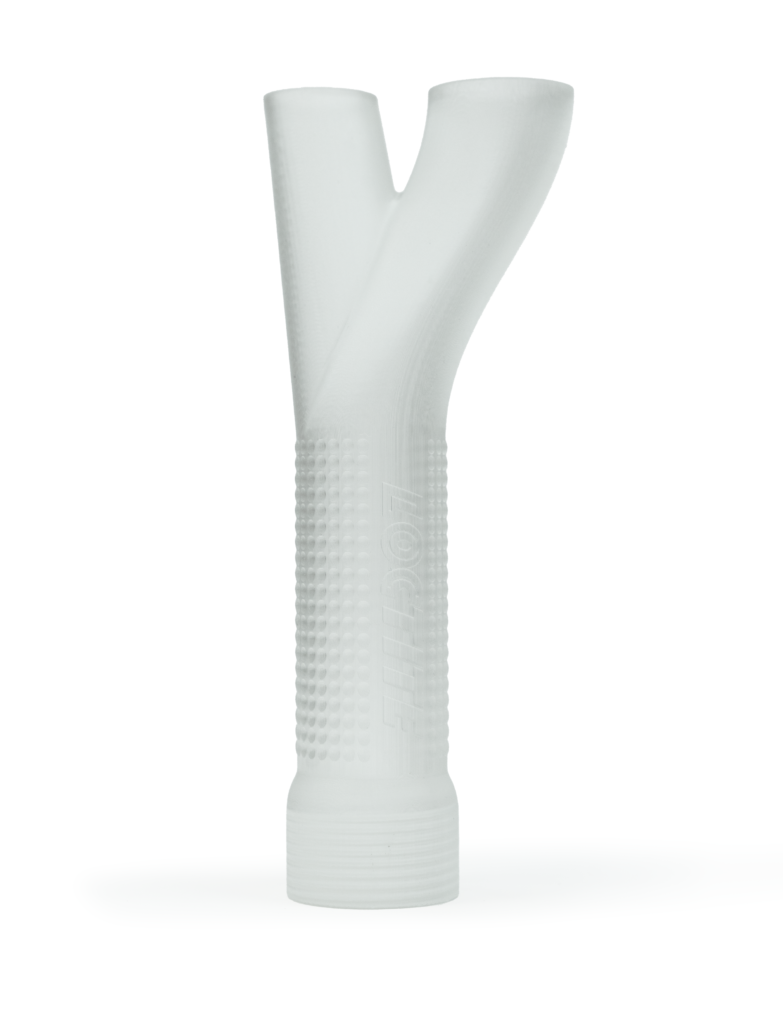

Hype machine Carbon has made a lot of waves in 3D printing with high-speed systems and innovative materials. Formerly, the company was one of the exponents of a closed materials approach, where they controlled everything from the machines, to maintenance and even the slicing files, but this has now changed. Carbon is partnering with chemicals giant Henkel to bring the latter’s Loctite resins to Carbon’s digital light synthesis (DLS) systems. The first material is the Loctite 3D IND405 Clear resin, a tough, clear material that could be used for finished goods and items such as jigs.
This type of photopolymer should be an interesting option for prototyping glass or packaging and general prototyping needs. At the same time, if the toughness, elongation, and durability hold up, it could open up new end-use parts for vat polymerization. Vat polymerization technologies such as Carbon’s DLS or SLA have always had problems making end-use parts. With materials companies’ recent investments, SLA and related technologies seem to be getting much closer to making products that can withstand prolonged use in the real world (outside of hearing aids, of course!). Simultaneously, lower costs and higher availability should engender more manufacturing applications with vat polymerization.
We must of course be cognizant of the fact that these acrylics are thermosets that can not be recycled in any meaningful way. Due to this—and the fact that thermoplastics for material extrusion and powder bed fusion are still significantly cheaper—photopolymer technologies still have a long way to go before these materials are viable in the manufacturing of large end-use parts. For objects such as personalized headphones, mass-customized items, and prototypes, these new developments could go very far in some production applications (if the relevant safety standards can be met). Because they’re using Carbon’s technology, the part size will also be quite limited, as is the universe of the makeable on the Carbon platform.
Dr. Simon Mawson, Senior Vice President and Head of 3D Printing at Henkel, said of the partnership:
“Henkel is a leading provider of single-component technologies for additive manufacturing, Our expanded partnership with Carbon allows us to deliver Loctite solutions to customers in the aerospace, automotive, industrial and medical markets. Together we offer an efficient additive manufacturing workflow that facilitates the production of durable end-use parts.”

“We believe that the single-component technologies from Loctite, coupled with the Carbon DLS process, provide a best-in-class solution that enables higher precision, better functionality and outstanding economics. Together that puts us in a great position to deliver on additive manufacturing’s promise to transform industrial manufacturing.”
Dr. Jason Rolland, Senior Vice President of Materials at Carbon, stated:
“We are excited to be partnering with Henkel to add this material to our portfolio of resins. Our customers have asked us for a clear material that is tough, durable and high-impact resistant. Loctite 3D IND405 meets those needs, and we’re committed to continuing to provide product developers the widest range of best-in-class materials.”
This news means that—along with Origin, Stratasys, RPS, and players such as Kings and Carima—the open vat polymerization space seems much more significant today than a few years ago. On the materials side, it also seems much more competitive, with Henkel, DSM, and Arkema Sartomer all coming out with new high-performance resins formulated for specific end-use applications for open machines.
Meanwhile, there’s a Cambrian explosion of desktop stereolithography (SLA) machines and a great deal of new work being done related to LEDs and other light sources. Vat polymerization is booming and that is truly not anything any of us felt ten years ago. The technology that made fragile, brittle, non-UV resistant parts is now really coming into stride. Outside of the tens of millions of parts made on EnvisionTEC systems and the continued progress of Formlabs, we’re really seeing a gradual opening of the market. Open systems enable lower prices, faster innovation, and allows manufacturers to have redundancy in suppliers.
A few years ago Carbon would have gone it alone. Indeed, it’s probable that they worked with both Henkel and Arkema to develop some of their materials. Now, however, we are in the ecosystem age, with the materials companies in the driving seat of a lot of recent developments. They will bring great deal of chemistry and polymer knowledge to furthering 3D printing for the entire industry. It is this age of partnerships and working together that will get us into new manufacturing niches and spread us out over the world.
If you're looking to get architectural 3D animation in the USA, our service provides an exceptional way to bring your architectural concepts to life through dynamic, immersive visuals. Through our platform, you can easily request high-quality 3D animations that showcase your designs in motion, offering a detailed view of your project from multiple angles and perspectives. Whether it's for a real estate development, a commercial building, or an urban planning project, our expert team ensures that every detail is captured in a visually compelling animation.
Through our website, you can seamlessly get architectural 3D animation tailored to your project’s specific needs. With our help, you can offer potential clients or investors an engaging experience that goes beyond static images. By integrating CGI animations with real-world settings, lighting, and textures, our team creates a lifelike experience that allows your audience to interact with your project as though it were already built. This service is perfect for presenting complex designs in a clear, visually attractive way that stands out in the competitive architectural market.




